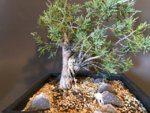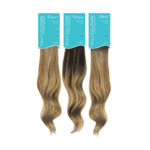Bonsai Nut
Nuttier than your average Nut
Not all California junipers are created equal  Not sure what the story is, but some have tighter foliage than others. Folks I know who collect from the high desert specifically avoid the ones with the leggy growth. Additionally, I agree with what @Adair M says about trees taking on different characteristics once they are removed from one environment and placed in another. @Si Nguyen showed me some California juniper in his garden that I swore were shimpaku - but he says he gets compact growth by supplementing with a ton of iron.
Not sure what the story is, but some have tighter foliage than others. Folks I know who collect from the high desert specifically avoid the ones with the leggy growth. Additionally, I agree with what @Adair M says about trees taking on different characteristics once they are removed from one environment and placed in another. @Si Nguyen showed me some California juniper in his garden that I swore were shimpaku - but he says he gets compact growth by supplementing with a ton of iron.
I got a Mendocino pygmy cypress from Bob Shimon earlier this year. It was just a small thing, pretty weak, and we spent a lot of time talking about how he collects them and how they are naturally dwarfed from growing in small pockets of soil, as an understory tree. He estimated the tree at being 75 years old - and the trunk is perhaps 1" thick. I transplanted it gently into an Anderson flat with good bonsai mix, and the foliage mass has probably doubled in the last 6 months. I am concerned that perhaps I am growing it too fast, and that I will lose some of the gnarly, chunky personality that exists on the older parts of the tree. So just because a tree is collected as a dwarf doesn't mean it is going to stay a dwarf when it is in good soil, getting plenty of sun and water and fertilizer.
Ryan Neil did an episode on bristlecone pines where he said more or less the same thing. The trees can be naturally dwarfed and slow-growing when up on the top of a mountain... but if you bring it down and care for it, you may be surprised how strong and relatively fast-growing they can be.
I got a Mendocino pygmy cypress from Bob Shimon earlier this year. It was just a small thing, pretty weak, and we spent a lot of time talking about how he collects them and how they are naturally dwarfed from growing in small pockets of soil, as an understory tree. He estimated the tree at being 75 years old - and the trunk is perhaps 1" thick. I transplanted it gently into an Anderson flat with good bonsai mix, and the foliage mass has probably doubled in the last 6 months. I am concerned that perhaps I am growing it too fast, and that I will lose some of the gnarly, chunky personality that exists on the older parts of the tree. So just because a tree is collected as a dwarf doesn't mean it is going to stay a dwarf when it is in good soil, getting plenty of sun and water and fertilizer.
Ryan Neil did an episode on bristlecone pines where he said more or less the same thing. The trees can be naturally dwarfed and slow-growing when up on the top of a mountain... but if you bring it down and care for it, you may be surprised how strong and relatively fast-growing they can be.




